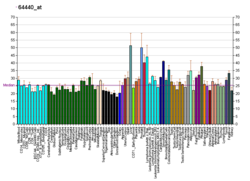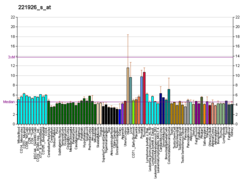
Interleukin 17 family is a family of pro-inflammatory cystine knot cytokines. They are produced by a group of T helper cell known as T helper 17 cell in response to their stimulation with IL-23. Originally, Th17 was identified in 1993 by Rouvier et al. who isolated IL17A transcript from a rodent T-cell hybridoma. The protein encoded by IL17A is a founding member of IL-17 family. IL17A protein exhibits a high homology with a viral IL-17-like protein encoded in the genome of T-lymphotropic rhadinovirus Herpesvirus saimiri. In rodents, IL-17A is often referred to as CTLA8.

The interleukin 4 receptor is a type I cytokine receptor. IL4R is its human gene.

Interleukin-12 receptor, beta 1, or IL-12Rβ1 in short, is a subunit of the interleukin 12 receptor and the interleukin 23 receptor. IL12RB1, is the name of its human gene. IL-12Rβ1 is also known as CD212.

Interleukin-1 receptor accessory protein is a protein that in humans is encoded by the IL1RAP gene.

Interleukin 15 receptor, alpha subunit is a subunit of the interleukin 15 receptor that in humans is encoded by the IL15RA gene.

Interleukin 9 receptor (IL9R) also known as CD129 is a type I cytokine receptor. IL9R also denotes its human gene.

Interleukin-13 receptor subunit alpha-2 (IL-13Rα2), also known as CD213A2, is a membrane bound protein that in humans is encoded by the IL13RA2 gene.

Interleukin-18-binding protein is a protein that in humans is encoded by the IL18BP gene.

Interleukin-1 family member 10 is a protein that in humans is encoded by the IL1F10 gene.

Vascular endothelial growth inhibitor (VEGI), also known as TNF-like ligand 1A (TL1A) and TNF superfamily member 15 (TNFSF15), is protein that in humans is encoded by the TNFSF15 gene. VEGI is an anti-angiogenic protein. It belongs to tumor necrosis factor (ligand) superfamily, where it is member 15. It is the sole known ligand for death receptor 3, and it can also be recognized by decoy receptor 3.

Interleukin 17 receptor A, also known as IL17RA and CDw217, is a human gene.

Interleukin-36 beta also known as interleukin-1 family member 8 (IL1F8) is a protein that in humans is encoded by the IL36B gene.

Interleukin 21 receptor is a type I cytokine receptor. IL21R is its human gene.

Interleukin 20 receptor, alpha subunit is a subunit for the interleukin-20 receptor. IL20RA is its human gene.

Interleukin-1 receptor-associated kinase 3 is an enzyme that in humans is encoded by the IRAK3 gene. Using in vivo liposome-mediated delivery of CRISPR/Cas9 plasmid expressing IRAK3 gRNA, IRAK3 was shown to be responsible for endotoxin-induced expression of A20 and VE-cadherin in endothelial cells. Thus, IRAK3 is crucial for maintenance and repair of endothelial barrier after endotoxin-induced lung injury.

Interleukin 18 receptor accessory protein, also known as IL18RAP and CDw218b, is a human gene.

Interleukin-1 receptor-like 2 is a protein that in humans is encoded by the IL1RL2 gene.

Cluster of differentiation CD79A also known as B-cell antigen receptor complex-associated protein alpha chain and MB-1 membrane glycoprotein, is a protein that in humans is encoded by the CD79A gene.

Interleukin 17F (IL-17F) is signaling protein that is in human is encoded by the IL17F gene and is considered a pro-inflammatory cytokine. This protein belongs to the interleukin 17 family and is mainly produced by the T helper 17 cells after their stimulation with interleukin 23. However, IL-17F can be also produced by a wide range of cell types, including innate immune cells and epithelial cells.
CKLF like MARVEL transmembrane domain-containing 4, formerly termed chemokine-like factor superfamily 4, is a small transmembrane protein which passes the plasma membrane four times. It has 3 known isoforms, the CMTM4-v1 to CMTM4-v3 proteins. Protein isoforms are variant products that are made by alternative splicing of a single gene. The gene for the CMTM4 isoforms is located in band 22 on the long arm of chromosome 16. The CMTM4 gene and its 3 isoform proteins belong to the CKLF-like MARVEL transmembrane domain-containing family of structurally and functionally related genes and proteins. CMTM4-v1 and CMTM4-v2 are widely expressed in multiple human tissue while CMTM4-v3 has been detected only in the kidney and placental tissues.


















